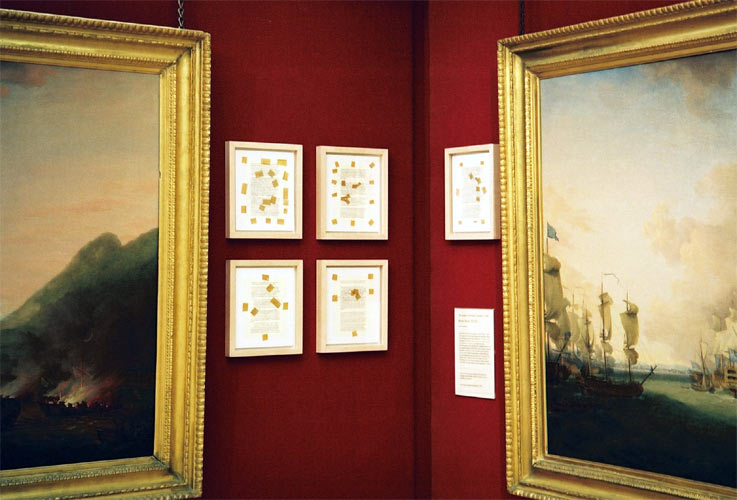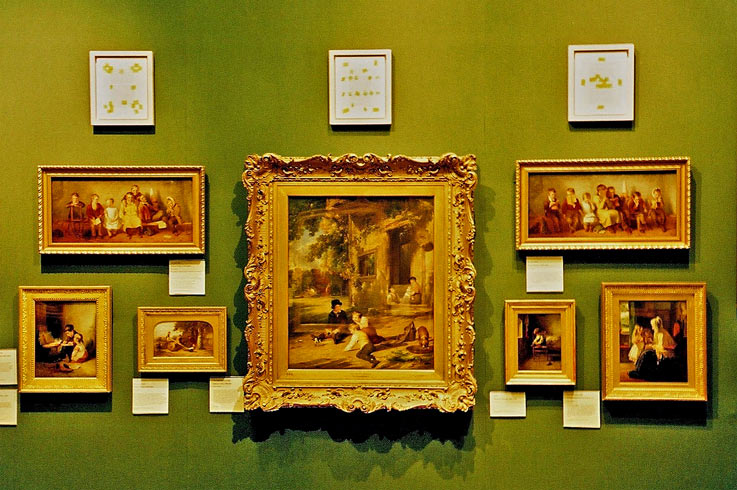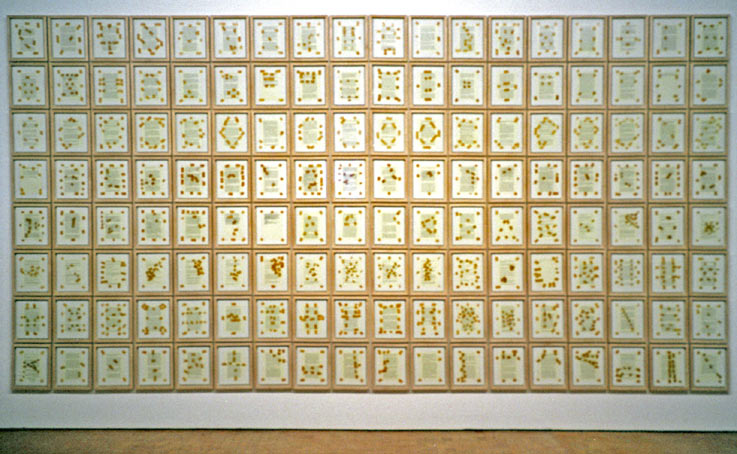‘Hoc opus hic labor est’ [1]
The work Now They Are Surrounded consists of 144 canvases each measuring 26cm × 31cm (Figures 1 and 2). On the surface of each canvas is depicted a page of text that has been torn or cut in some way and then repaired with rather mangy Sellotape. In other words, the work consists of 144 pictures. The pictures are framed and glazed in such a way as to leave a small gap between the edge of the canvas and the frame. For this exhibition, the 144 framed pictures have been photographed and configured as an interactive projection that can be reconfigured in a number of ways [2]
The exhibition is offered as an essay-like contribution with regard to a Symposium, ‘Systems Art’, organised jointly with London Metropolitan University, Whitechapel Art Gallery, and The National College of Art and Design Dublin, 26th and 27th October 2007[3]
The work Now They Are Surrounded was first exhibited at the Guildhall Art Gallery, 2005, and had been made specifically for the occasion. The framed canvasses were distributed around the gallery singly or in groups. In many cases they might easily have been taken for information about the paintings they adjoin. They sidled into the practical and thus cultural territory of the curators and did not immediately, if at all, claim the attention of the viewer as the equivalents of the paintings on display.

fig. 1
In producing the work, we kept two thematic questions in view:
1. How might a work be conceived that addressed its own external and unwanted conditions, and at the same time sustain a kind of internality?
2. Would a change in the circumstances in which the work was exhibited change its internal description?
Thus it was envisaged that the work would indeed be installed in altered configurations in other circumstances. One such circumstance occurred at ZKM, Karlsruhe in November 2005 (figure 3). This present occasion constitutes another (Unit 2 Gallery London Metropolitan University 2007).
Internality is something we require of our own work. What we have in mind is the internality that is necessary to autopoeisis. An autopoeitic system is one that knows about itself, is recursive, and ‘as a consequence of this’ is empowered to know about the world outside. It is in virtue of this dialectical internality that the work of art can work to resist entry by those agencies whose secular power rests on the solipsistic arbitrariness of meaning. Such a work is in one way or another in a position to disconfirm some interpretations and to dispute certain usages. It is not made simply by the relations that compose its internal structure, but rather by a self-description that these relations imply.
Further, it is a condition of the aesthetic, political and social morale of our own work that it be project-like or essay-like; that it be a response to a problem or puzzle, and not just be hitched on to one of the versions of ‘inner necessity’ by which media-led generic art tends to be rendered consumable. When we say that the work is project-like or essay-like we mean that we do not seek the kinds of spurious psychological and stylistic continuities by which artists’ oeuvres are supposed to be distinguished and out of which their cultural content is partly formed. Instead, we have a conversation of sorts; we try to sustain a discursive, and indeed a recursive practice that looks at itself as well as outwards. This conversational practice may be exemplified by – or lead to – at least two types of production or work: artworks and a form of critical and theoretical literature. As we intend it, the conversation is awake to itself as a practice and represents a continuity of sorts, albeit one that could not be tracked in terms of the differentiae that would conventionally be used to trace an oeuvre. Our work’s aim is not simply to reflect or to instantiate our conversational and inquisitive processes, but also to be part of them. There is no paradox in this.
If we ask what work the artwork is to do, then the answer is that it should take on a question that has been put to a project. A corollary of this is that it should avail one of a critical description of the set of circumstances to which it is a response. We do not argue that what we may propose will be the only possible description of the given conditions. All we are saying is that, one way or another, it is necessary to look ‘at’ and ‘to’ the world to set an agenda.
Now they are Surrounded, is assuredly pictorial. It consists of pictures that among other things picture texts. A viewer might ask if she should regard the work first as picture and then as text or vice versa.
While we acknowledge that reading and ‘looking’ are distinct, we suggest that reading the text in a textual picture is in some sense equivalent to understanding certain iconographic or technical principles, and that these go to the picture’s having an internal subject. What then is the significance of the other marks on the paper: the pictorial representation of cuts and holes, the simulated Sellotape and so on?

fig. 2
The short answer is that these are pictorial simulations of the literal properties of a surface upon which the text is inscribed. The picture plane is the literal surface of the canvas. The pictured cuts and holes with their sellotaped repairs are also capable of both external and internal description.
Is it also part of the subject of these pictures that they are sometimes related to one another – that they form a number of continuous texts? Perhaps we have to say that being part of a continuous text is, as it were, the internal subject of the pictures, since it is – at least largely – dependent on the texts being read and understood. The picture’s being part of a continuous whole is also a consequence of a judgement that this reading order imposes some sequence on the assemblage of pictures themselves – an order that supervenes possible alternatives.
As a kind of counter to the idea that this order is determined by the sequence of the texts, we might ask what case could be mounted for saying that the order of the pictures is on the contrary determined – as it were formally – by the patterns of virtual cuts or of fake Sellotape. Does it follow that the texts are the figure and the cuts and so on part of the ground? Or are all three elements competing for figure status in a contest that is incapable of resolution? Is this to ask whether from a figure/ground perspective Now They Are Surrounded is inherently unstable? Could we say that it is this figure/ground instability that assists the work in preserving its internality through actual or imagined changes of circumstance?
Perhaps we can now begin to try to say more clearly what we mean by ‘internality’. The internal subject of a picture will be defined not only by certain technical and iconographical considerations, but also by the picture’s capacity to engage the viewer in the questions that arise in the light of these. This is what an adequate description – or set of descriptions – will attempt to capture. We might say that the artwork that lacks internality will have no such description. Its external definition will suffice as an account of its content
Can we now say that changing the circumstances in which the work is exhibited has changed its internal description? How are considerations of internality born upon by the two circumstances which have seen Now They Are Surrounded installed as the gridded occupant of a single wall at ZKM and now as an interactive work that offers multiple configurations? Can we say Now They Are Surrounded has preserved all or some of its critical negativity?

fig. 3
With 144 items, the possible permutations are legion. The gridded block, 8 frames high and 18 wide at ZKM occupied roughly the same amount of space as a very large modernist painting. The whole measured just over 2.5m × 5m, roughly the same dimensions as Barnett Newman’s Vir Heroicus Sublimis. Here Now They Are Surrounded is exhibited not only in a new formation relative to the two previous occasions, but it has also been transformed into Now They Are Surrounded: Reconfigured. The latter title marks a double change. We might call one of them ‘material’ and the other ‘formal’. The status of both picture and frame as sign is now unmistakable, and, relieved of the need for screws and rulers, its spatial distribution is in the hands of the viewer, who can in some measure manipulate the relations between detail and a totalising view of the virtual ‘whole’. The small pictures in their frames are now rendered wholly as images. We are looking now at a picture of a picture and a picture of its frame and these images are distributed by means of an interactive programme.
As Now They Are Surrounded was installed at ZKM, any sense of its internality remained dependant upon there being an internal description which the long view avails, to the effect that it is composed in the form of a conspicuous and aesthetically more or less plausible occupier of white institutional space. We might say that the long view makes for a culturally astute spectator of a kind, but it will be one who is bereft of competence with regard to certain internal features of the work. The sense of the work’s internality also depended upon its being seen as consisting of texts with small marks and adhesions. It might even be said that these marks and adhesions form patterns of abjection and poverty. These are internal features that determine what the work is. The point is that Now They Are Surrounded is dependent for its meaning on this mutual negation of each regard by the other. It is not shuffling back and forth that will avail one of the 'whole'. We might say, rather, that there is nowhere to stand. It is an internal condition of Now They Are Surrounded that this is the case – wherever and however it may be installed and indeed, reconfigured.
Chris Smith / Art & Language
=================================
[1]. ‘Only the Overcoming of difficulties makes a work significant: Hoc opus hic labor est’ - Luhmann.2000 N, Art As A Social System, Translated by Eva M. Knodt, Stanford University Press, Stanford, California, p 315
[2]. Annie Spinster and Chris Smith, from Now They Are Surrounded, Art & Language 2005, 2007
[3]. Nicolas Luhmann makes particular reference to Art & Language in Art as a Social System: op cit, p295
No comments:
Post a Comment